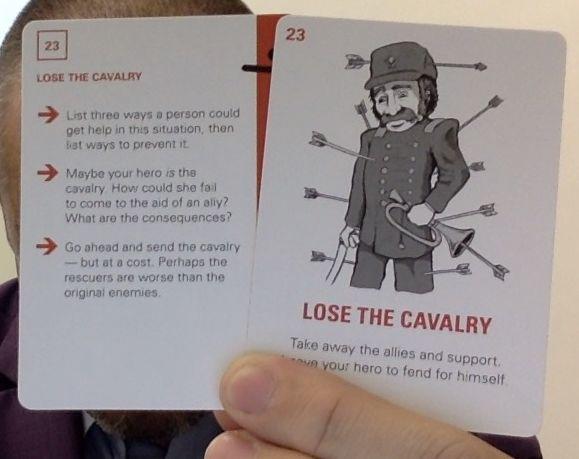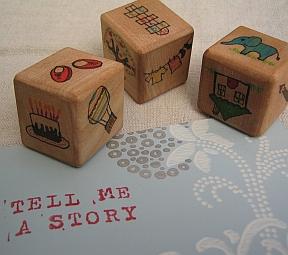The Writer Emergency Pack

I received John August’s Writer Emergency Pack via the mail this week. The idea behind it is simple: two decks of 26 cards each, numbered 1 through 26 twice. One deck has illustrated Idea cards, like the “Lose the Cavalry” card showing the cavalry soldier doing his Sean Bean imitation. The other card with the same number is the Detail card. One side has a bit of narration explaining the idea of the idea card. The other side (shown in the pic) has specific suggestions about how to implement the idea. In game mode, players start with a well-known story, such as Hamlet or Curious George. They then take turns retelling the tale based on their respective cards. After spring break, which is next week, I shall introduce at least my 8th graders to these cards.
For this post, I’m looking at the cards as a tool for generating ideas when writing. This could be fiction writing for a lark, class assignment writing for a grade, or adventure writing for a game. In order to put the Writer Emergency Pack into play, I need a story; therefore, “The Shepherd’s Boy and the Wolf” from Aesop’s Fables as told by J. H. Stickney, published in 1915 by Ginn and Company. Next, I draw three Idea cards after shuffling the decks. I get Fight the Giant, Narrator, and Talk It Out. The story is already in third person, so Narrator doesn’t really fit. Between the other two, I like Talk It Out the best. I follow the instructions on the accompanying Detail card.
1. Three locations or situations in which the shepherd boy and the wolf could talk at length?
The most obvious location is the meadow where the sheep graze. Perhaps the boy tracks the wolf back to its lair, or the wolf tracks the boy back to his home.
2. Three characters the shepherd boy could confide in?
The shepherd boy works for the sheep’s owner. The shepherd boy likely has family: parents, an older sibling. A farmer irate at the boy’s pranks might take pity on the boy and offer a friendly ear.
3. A conversation between the shepherd boy and his younger self. What advice would he give?
This one stumped me at first. I mean, the shepherd boy is a boy. His younger self would be even boy-er. But, why fight it? This might be counterpoint to the advice received by the boy’s confidants. The boy’s inner voice urges him toward further shenanigans. Or, perhaps, through the “conversation”, the boy remembers simpler, better times when obedience and duty didn’t seem to be so burdensome.
4. The antagonist is nonhuman. How does the wolf speak? How does it describe what it wants?
It’s a fable. The wolf talks, most likely with a German accent. The wolf wants lamb, but the only way he knows how to get it is to be a predator.
When I put this together, the familiar fable refashions into a different tale. At some point in the story, the boy and wolf have a talk. They explain their respective positions. Doubtless, accusations and misunderstandings arise. Since the boy is a bit of a lout and the wolf is, well, a wolf, I hear them reaching some sort of accord. The shepherd boy agrees to give the wolf X number of sheep as payment for revenge against those who mocked the boy, for example. Or, perhaps, the boy and wolf become friends. Sure, the wolf still eats the sheep, but so do the people in the village from which the boy comes. In this scenario, however, the wolf and the boy team up to defend the sheep and the maybe the village itself against a wolf pack under the command of a Big Bad Wolf. That way, we get some exciting action scenes, and both the boy and the wolf earn a place of respect in the community.
Regardless of which way I would take the story, the familiar fable becomes something rather different, and therein lies the fun. The Detail cards suggest rather than prescribe or proscribe. In answering the questions a Detail card asks, I’m still the creative force. My likes, dislikes, personality, et cetera, drive the story from the starting points of the Detail card’s questions.
If the Writer Emergency Pack works well in class, I’m inclined to seek out some of John August’s other products.
 At the start of every adventure (or game session, whichever you prefer), each player gets six Story Dice, which are d4s set aside in some sort of suitable receptacle or space so as to not confused with regular d4s. (Did you notice the alliteration?) Whenever a PC performs an action, the player can choose to roll between one to three Story Dice instead of whatever he’d normally roll for action resolution. (If you’re using
At the start of every adventure (or game session, whichever you prefer), each player gets six Story Dice, which are d4s set aside in some sort of suitable receptacle or space so as to not confused with regular d4s. (Did you notice the alliteration?) Whenever a PC performs an action, the player can choose to roll between one to three Story Dice instead of whatever he’d normally roll for action resolution. (If you’re using 